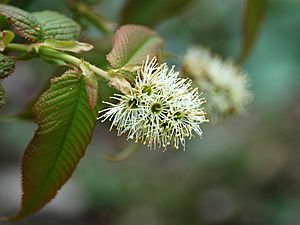Prunus himalayana facts for kids
Quick facts for kids Prunus himalayana |
|
|---|---|
 |
|
| Scientific classification | |
| Synonyms | |
|
Prunus himalayana is a type of Prunus tree, which is a group of plants that includes cherries and plums. This tree is also known by other names. In Tibetan, it's called jyokun shin, and in Chinese, it's known as 喜马拉雅臭樱 (which means 'Himalayan Stink Cherry').
This unique tree grows naturally in the high mountains of the Himalayas. You can find it in countries like Nepal, Bhutan, Sikkim, and Tibet. It prefers to live at very high altitudes, usually between 2,800 and 4,200 meters (about 9,200 to 13,800 feet) above sea level. For a while, scientists called it Maddenia himalaica, but they later decided it was a true Prunus species.
Contents
What the Himalayan Cherry Tree Looks Like
The Prunus himalayana tree usually grows to be about 3 to 8 meters (10 to 26 feet) tall. Sometimes, it can even reach up to 10 meters (33 feet) high!
Bark and Branches
The older branches of this tree have shiny bark. It can be brownish-purple or brownish-red. Younger branches have brownish-red bark that starts out fuzzy but later becomes smooth. The winter buds, which are like tiny packages holding new leaves and flowers, are purplish-red and shaped like an egg.
Leaves
The leaves of the Himalayan Cherry are quite interesting. They are dark green on top and pale green underneath. The underside of the leaves is often fuzzy, especially along the main veins. Each leaf has many veins, usually between 15 and 20 pairs. When the leaves are young, their edges have tiny glands.
The tree actually produces two different kinds of leaves!
- Leaves on non-flowering shoots: These leaves are long and narrow, sometimes oval-shaped. They are usually 5 to 15 cm (2 to 6 inches) long. Their bases can be rounded or heart-shaped, and their tips are pointed.
- Leaves on flowering shoots: These leaves are more oval or spear-shaped. They are a bit shorter, usually 5 to 9.5 cm (2 to 3.7 inches) long. They have heart-shaped bases and pointed tips.
Flowers and Fruit
The flowers of the Prunus himalayana grow in clusters called racemes. Each cluster can have 10 to 20 flowers. These clusters are about 3.5 to 6 cm (1.4 to 2.4 inches) long.
Flowers
Each flower is small, about 2 to 4 mm (0.08 to 0.16 inches) across. The flower stems are fuzzy and grow longer as the fruit develops. The outer parts of the flower, called sepals, are brownish and fuzzy. Inside, the flower has 20 to 30 stamens, which are the parts that produce pollen. The petals are not very noticeable.
Fruit and Life Cycle
After the flowers bloom, the tree produces small, oval-shaped fruits called drupes. When they are ripe, these fruits turn purple. Each fruit is about 9 mm (0.35 inches) wide.
The Prunus himalayana tree typically flowers in May. Its fruits then ripen and are ready to be picked in June.

